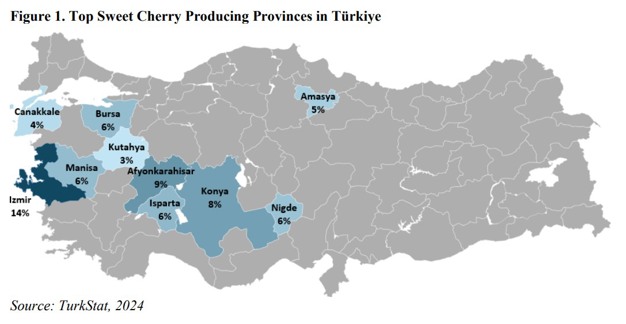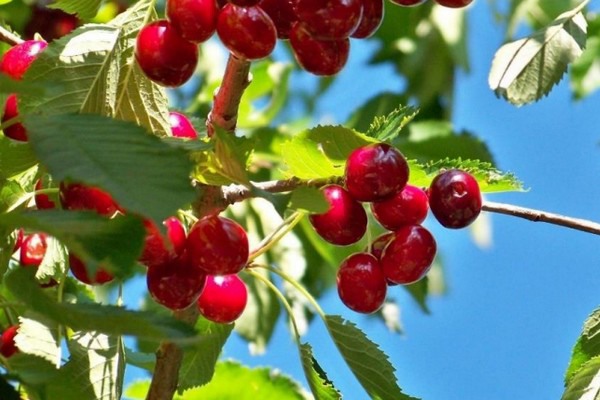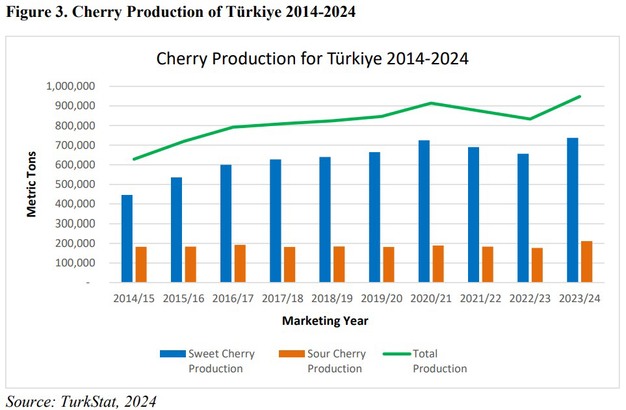Turkiye's cherry production for marketing year (MY) 2024/25 is forecast down from last year's record, but is still the third largest on the books. Despite the contraction in production, cherry exports are forecast to hit an all-time high as growers prioritize sales abroad since it's more profitable then selling on the local market. The production and export of peaches and nectarines are set to reach record levels as larger growers continue to expand operations to capitalize on profit-generating exports. Amid this record-setting year, some smaller stone fruit growers, who are only able to sell to the domestic market, are struggling to make ends meet because the cost of on-farm inputs (e.g. labor, fuel, electricity, etc.) is growing at a faster clip than farm gate prices for their fruit.

Planting Area
The MY 24/25 area planted in cherries – both sweet and sour – is forecast slightly higher from the previous year at 99,300 hectares. This forecasted area is made up of 80,000 ha of sweet cherries and 19,300 ha of sour cherries. For the last decade, the total area planted in cherries has hovered around 100,000 ha.
Although the area planted has remained fairly constant during this ten-year period, the numbers of sweet cherry bearing trees have increased (i.e., densification) as growers have modernized their operations. According to Turkish statistics, the number of sweet cherry bearing trees increased from 21.0 million to about 27.0 million from 2019 to 2024, while the number of sour cherry bearing trees has stayed relatively flat.

Türkiye is home to more than 100 varieties of sweet cherries. The most popular variety is the Napolean sweet cherry, known locally as the 0900 Ziraat. It is a large, juicy, heart-shaped cherry that has a longer shelf life than other varieties, making it the ideal cherry for shipping long distances in-country and abroad. Over the last decade, Turkish scientists have developed higher yielding and better-quality Napolean cherries. Growers have gradually replaced the older Napolean variety with newer and improved versions. In addition to the Napolean cherry, growers have also started experimenting with other high yielding sweet cherry varieties, such as Sweetheart, Celeste, Early Lory, Kordia, Regina, Sam, and Sunburst.
Production
For MY 2024/25, Post forecasts total cherry production at 900,000 MT, which is down about 5 percent from last year's record because growing conditions this season weren't as ideal. Even though production is projected to decline, it will still be the third largest on record. The total forecasted amount is made up of 700,000 MT of sweet cherries and 200,000 MT of sour cherries. Post's forecast is based on fieldtrips and conversations with cherry growers which revealed that the timing and amount of rainfall was adequate, and that there hadn't been any frost damage in the spring.

The Turkish statistical agency (TurkStat) projected MY 2024/25 total cherry production at 988,000 MT, of which 771,000 MT is sweet cherries and the remaining 217,000 MT is sour cherries. One reason the TurkStat forecast is different than Post's number is because TurkStat made its projection in early May just as the harvest season was beginning.
Cherry production is mainly concentrated in the western side of Türkiye. The coastal province of Izmir and the inland province of Afyonkarahisar are the two leading provinces for sweet and sour cherry production, respectively. The marketing year for cherries in Türkiye begins in May and lasts through early August. The exact timing of the cherry season can vary depending on the region and weather conditions, but generally, the peak harvest period for cherries begins in June. The cherry harvest first starts in Izmir, located on the Aegean coast in late May and later moves to the inland provinces like Afyonkarahisar and Konya in June and July.
For the full USDA report, please click here.










